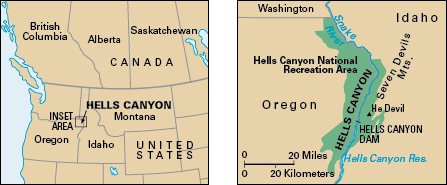Hells Canyon is one of the deepest river gorges in North America . The canyon , carved by the Snake River , lies on the border of western Idaho and northeastern Oregon in the northwestern United States. The gorge is sometimes called the Grand Canyon of the Snake River. The Grand Canyon , in the southwestern United States, is one of the most spectacular canyons in the world.

Hells Canyon is about 125 miles (201 kilometers) long. It is 10 miles (16 kilometers) wide at its widest point. At its deepest, the gorge drops about 7,900 feet (2,400 meters) to the river’s surface from Idaho’s He Devil peak on the canyon’s east rim.
The canyon lies within the Hells Canyon National Recreation Area, part of the Wallowa-Whitman National Forest. The Hells Canyon Wilderness lies within the recreation area. Visitors there enjoy camping, hiking, sightseeing, whitewater rafting, and other outdoor activities. Hells Canyon Dam forms a reservoir on the river near the southern entrance to the recreation area. The area is known for its rugged mountain peaks, dense forests, and numerous scenic overlooks. Dry, desertlike areas are found along the canyon floor.
The Hells Canyon region has been home to Native American groups for thousands of years. United States settlers came into the area in the mid-1800’s. Prospectors found gold there in the 1860’s. In 1877, the Nez Perce crossed the canyon while fleeing U.S. Army soldiers. Early names for the gorge included Snake River Canyon and Grand Canyon of the Snake River. The origin of the name Hells Canyon is unknown. Geographers have speculated that the name comes from the canyon’s forbidding terrain, the warm summertime temperatures at its lower elevations, and its position below the towering Seven Devils Mountains.
